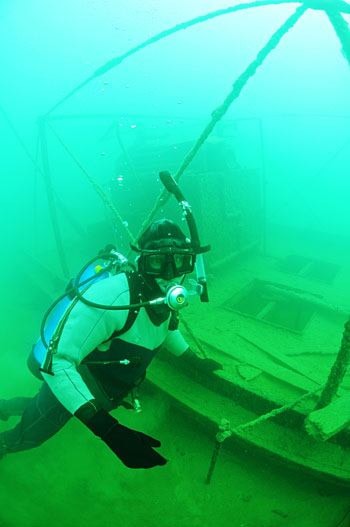Archeologists have identified the music aboard a Klondike Gold Rush sternwheeler that sank 110 years ago.
An international team dove beneath the cold waters of Lake Laberge last summer to document the remains of the A.J. Goddard, which went down in a severe storm in 1901, killing three of the five crewmen.
Among the most surprising discoveries was a gramophone and three seven-inch records stamped into hard rubber.
“It’s an unexpected find for this particular vessel,” said Val Monahan, a conservator with the Yukon government’s Department of Tourism and Culture.
“This thing was kind of like a long-haul truck. It was not like the SS Klondike, which had cabins and a dining room, and you could pay money for a nice trip to Dawson. It was nothing like that.
WATCH VIDEO:Haunting images of the A.J. Goddard.
“It didn’t even have enclosed cabin spaces. It had a little cabin house. And it had canvas to cover the rest of it. It was a small vessel, between 15 to 16 metres. Basically, it hauled freight and firewood.”
“You wouldn’t expect to find (a gramophone), in what was a pretty rough-and-ready circumstance. It’s a little moment of luxury for these guys.”
The records were fairly easy to identify. Information was stamped directly onto the rubber of the disc centres.
The records probably won’t ever be played again. Their grooves are deep, uneven and full of rust. “If you played them, they’re so brittle and full of iron, you’d probably just grind the grooves off,” said Monahan.
But the records were mass-produced, and other copies still exist. So far, two of the three have been tracked down at the American Library of Congress.
The records contain a waltz, an old Irish drinking song and an American minstrel tune.
Lindsey Thomas, a Texas-based archeology graduate student who worked on the shipwreck, calls the records “an incredible find. It’s something we honestly weren’t expecting.”
The gramophone probably cost $15 at the time, she said. That’s “less than most of the gramophones at the time, but still quite a lot of money for an entertainment item.”
Given how the item would be “bulky, large and probably quite delicate,” it probably took “quite a lot of energy” on the crew’s part to ensure it remained safe.
That shows the importance of music to the crews that worked on the Yukon River, said Thomas. She’s dug through archival records to demonstrate how many pioneers valued music to “hold up better under the trying circumstances.”
The A.J. Goddard was among the first sternwheelers to reach Dawson City during the Gold Rush of 1898, said Thomas.
“We believe it originally came from San Francisco, purchased by the Upper Yukon Company, which is made up by Claire and Albert Goddard, and their business partner.
“They carried it over the mountains in pieces and assembled it at Lake Bennett. Then, when the ice broke in the summer of 1898, they rushed downriver with the rest the boats, and were the first small sternwheeler to arrive in Dawson. It’s an amazing story.”
The Yukon Transport Museum is planning an exhibit on the shipwreck this spring. But it will likely have to wait until the autumn for the gramophone and other delicate items to be properly restored by experts at the Canadian Conservation Institute.
Contact John Thompson at
johnt@yukon-news.com.
